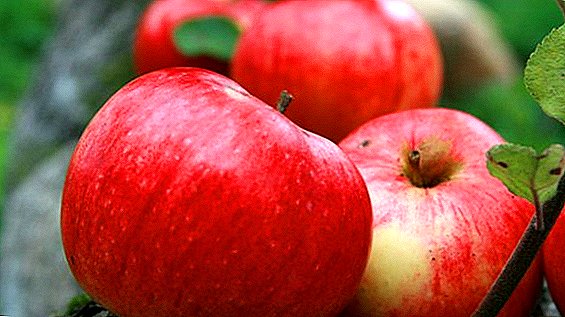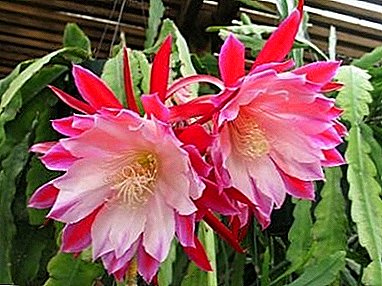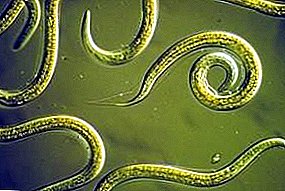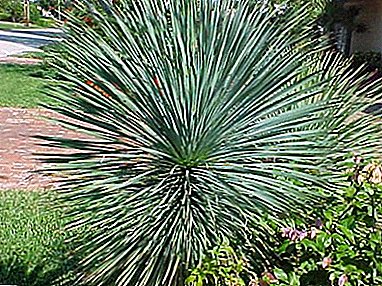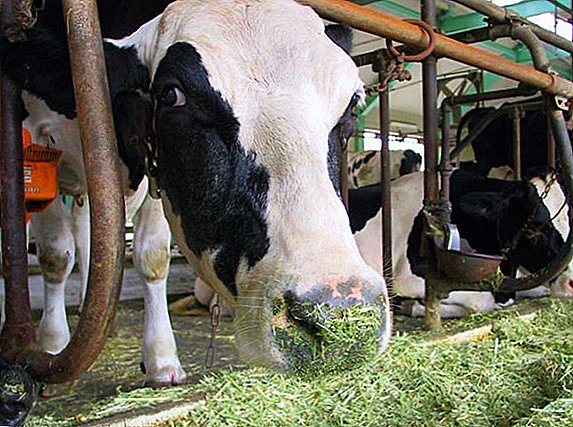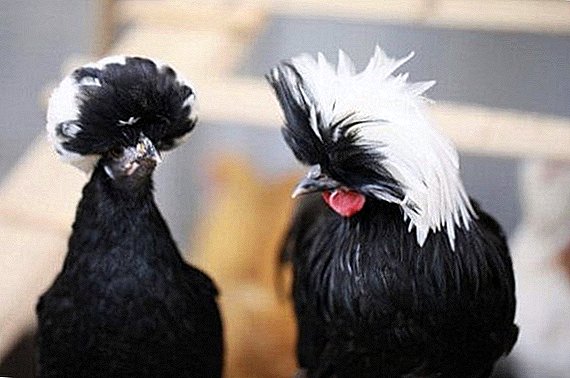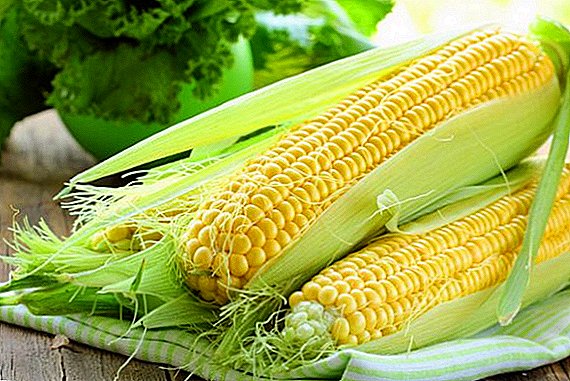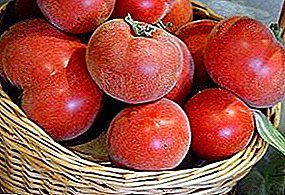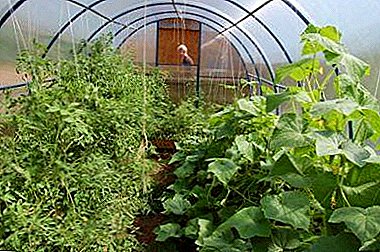
The construction of a spacious greenhouse is an expensive pleasure, and few gardeners will allow themselves separate structures for different vegetable crops. Quite often there is a need for joint cultivation of crops that have different needs.
Many novice gardeners wonder whether it is possible to create such conditions and microclimate so that cucumbers and tomatoes feel comfortable in the same room. All the subtleties and nuances of planting two crops in one greenhouse will be discussed in this article.
Is it possible to grow crops together in a greenhouse?
Is it worth it?
 Tomatoes and cucumbers are diverse crops, so when asked if they can be planted next to each other, the answer is possible, but this will entail certain difficulties.
Tomatoes and cucumbers are diverse crops, so when asked if they can be planted next to each other, the answer is possible, but this will entail certain difficulties.
Since the frequency of watering, air humidity, the degree of illumination, the number of dressings for each plant is different - you will have to find a way to create conditions for each of them. In an inappropriate microclimate, plants are often sick and wither, therefore the main difficulty is the combination of different growing conditions.
Gardeners, who rely on particularly high yields, should not plant cucumbers and tomatoes together. But those who are fascinated by the process itself, and not the mass of the crop in kilograms, it is quite possible to do this troublesome, but interesting thing.
Advantages and disadvantages
When these cultures are adjacent, the following negative aspects are distinguished:
- plants negatively affect each other;
- have significant differences in agricultural technology;
- requires the creation of different climatic conditions.
Among the positive aspects, it is possible to single out the fact that co-location greatly saves space; it is a rational way to produce different vegetables per unit area. In addition, different cultures prevent the depletion of the soil unilaterally, which has a positive effect on the taste of the fruit. The most compelling argument is that it is economically profitable for a gardener to build just one greenhouse.
Preparatory activities
What should be a common greenhouse?
For thermophilic tomatoes take the southern side of the greenhouse. Cucumbers fit the northern side, as from the direct rays of the sun the leaves of the plant wither. If the greenhouse is located next to another building, then it is better to place the cucumbers in the part where the shadow of the neighboring building falls.
 Optimum temperature for active growth of tomatoes - 21-26⁰С, although this vegetable carries well and hotter conditions. He also needs regular airing and does not need frequent watering.
Optimum temperature for active growth of tomatoes - 21-26⁰С, although this vegetable carries well and hotter conditions. He also needs regular airing and does not need frequent watering.
Cucumbers, on the contrary, require constant moisture and high humidity in the room. They practically do not need airing, the temperature for growth and the ovary is 19-23 ° C.
But with a strong cold snap, both plants are affected at night (below 18 ° C). In addition, the necessary moisture for cucumbers, detrimental effect on the pollination process of tomatoes, pollen sticks together, and if the temperature exceeds 30⁰s, the flowers can fall off at all. Wet microclimate leads to the development of fungal diseases in tomatoes.
Be sure to maintain the distance between cultures. It is believed that the open space contributes to the averaging of humidity and temperature, then vegetables will be able to transfer the neighborhood more easily. Tomatoes are planted under the vents or in the center of the greenhouse, and cucumbers are farther from the door and vents, and closer to the greenhouse walls (zoning).
Separation when installing a transverse partition that isolates vegetables is more efficient. Of course, you will have to provide two entrances, but as a result, each plant will receive exactly the care and microclimate that it needs. To get the best result and grow an excellent crop of both tomatoes and cucumbers, it is worth using a common polycarbonate greenhouse for joint planting and growing - it is more convenient to plant crops in them and plants are warmer there.
If the factory design does not contain internal partitions, they are made independently of dense polyethylene or plexiglas. Such partitions will help keep the microclimate different and organize different watering.
Special varieties for co-cultivation
Selection of seed is extremely important. From the side of tomatoes, the main criteria are resistance to late blight and wet microclimate. Agronomists developed hybrid varieties that, with their strong immunity, tolerate high humidity quite well.
Among resistant tomatoes distinguish varieties:
- Dubrava;
- De Barao Black;
- Oak tree;
- Dwarf;
- Union 8;
- Blizzard;
- Tsar Peter;
- La la fa;
- New Year;
- Lark
As for cucumbers, they choose cold-resistant and resistant to temperature extremes. Since inappropriate temperature regime causes a whole range of diseases that easily go to the neighboring tomatoes.
 Cucumber hybrids easily tolerate regular airing, so necessary for tomatoes, and are resistant to many diseases.
Cucumber hybrids easily tolerate regular airing, so necessary for tomatoes, and are resistant to many diseases.
For joint growth choose varieties:
- Masha;
- Leandro;
- Crane;
- Benefit;
- Princess;
- Goosebump;
- Pasadena;
- Natalie;
- Thumb boy;
- Nightingale;
- Diva.
Priming
Soil preparation begins in the autumn, manure, humus, and tops are laid in the beds. Add complex fertilizers. From above, everything is covered with a layer of earth, and by the spring the fertile soil for vegetables will be ready. A few weeks before planting the land in the greenhouse is heatedFor this purpose, it is covered with black film and the door is tightly closed.
Disinfection occupies an important place in the preparation of the soil; the most accessible option is to treat the soil with a solution of potassium permanganate.
Of course, for planting seedlings, some use a purchased substrate, but you can also prepare such a composition:
- They take peat as a basis, add humus, sawdust, sand in a ratio of 1: 1: 0.5.
- Then they dig up and enrich it with double superphosphate (2 teaspoons) and wood ash (0.5 kg).
Soil before planting fertilized with urea, potassium sulfate and potassium magnesia.
How to plant: step by step instructions
It is difficult to say exactly when to plant plants in the greenhouse. It depends on the climatic conditions of the area, the temperature of the soil, the growing season of the cultivar. Cucumbers are more cold-resistant, and they are planted in the greenhouse from the beginning of April until the end of May, for tomato planting dates are from the beginning of May to the beginning of June. The air temperature should not be below 15 ° C, the same applies to the soil.
Seeds
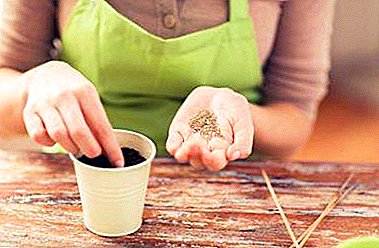 Before sowing the seeds they are sorted and removed shriveled and dark.
Before sowing the seeds they are sorted and removed shriveled and dark.- In order to instill in plants resistance to cooling, the sowing mass is quenched (placed in the cold for several days).
- They also carry out nutrient processing and disinfection with manganese solution (1%).
- To speed up the germination of seeds they are soaked. It is recommended not to throw them into the water, but to wet the gauze and wrap the seeds in it. If the planting material is of high quality, they will hatch within 5 days.
- Then they are planted in prepared containers (cups or boxes). To do this, moisten the ground, lay out the seeds, cover them with a thin layer of the substrate (0.5-1 cm).
- To prevent evaporation of the liquid and accelerate the emergence of seedlings, the seed container is covered with a film.
- After the appearance of 4-5 true leaves, seedlings are transplanted into the ground.
Seedlings
Seedlings need to thin out and swoop down.This is done to remove weak and unhealthy shoots and to provide strong growth for free growth and development. In cramped shoots will be weak and elongated.
Carrying out a picking, take two seedlings and transplant them to a prepared place, taking care not to damage the roots. When transplanting into the ground, the wells and rows are prepared in advance. Seedlings are transplanted directly with a clod of earth at the root and into moist soil. The earth around the hole is slightly tamped and watered.
Cucumber seedlings tolerate transplantation hard, the roots are very weak and sensitive, so when using the seedling method it is better to take a container without a bottom, or one that can be planted with a sprout (paper cup). When planting in the prepared soil, dry seeds are placed in the pits, no more than 4-5 seeds per square meter, or with a distance between the seeds of about 40 cm.
As for the characteristics of the joint cultivation of cucumbers and tomatoes, these include:
- Control of humidity and temperature - the best options are 70% humidity and 25⁰С.
- Sufficient width of the aisles and planting crops on opposite beds, with this method of separation can be planted tall varieties of tomatoes.
- A bed of greenery in a common greenhouse will help maintain the desired humidity.
- In the presence of a partition to support different conditions is much easier.
A photo
Below you can see how the crops are located in the common greenhouse, after they were planted:



How to care?
Watering and fertilizer
Before flowering, cucumbers are watered once every five days, when they bloom - two or three times a week, in a hot time - every other day, and not cold, but distilled warm water. Top-dressings are applied throughout the life of the plant, about 1 time in 7-10 days (the least amount of fertilizer per season - 5-6 times). Use mineral fertilizers, used according to the instructions on the package.
Tomatoes are watered at the root, about once a week, focusing on the drying of the top layer of the soil, just like in the case of cucumbers, the water is taken warm. Top dressing should be nitrogenous, for this purpose they use manure and chicken manure, superphosphate and ash. Urea is also suitable. Fertilizers are applied after watering every 10 days.
Trimming and pinching, pasynkovanie
To increase the yield and improve the taste of cucumbers, do nip and pasynkovanie. Up to half a meter, all lateral processes are removed, above — lateral shoots are clamped after the first leaf, at a height of 1.5 meters, pinching is done after the second leaf. It turns out - the closer to the root, the shorter the side shoots.
Passing begin after 4 leaves appear on the stem. All the extra flowers and spikes are sacrificial until the eleventh leaf appears, then pinch the top.
Tomatoes also need to be staved, for this they remove all lateral shoots, leaving the main stem. Pinch the top done after the seventh fruit of the brush. For low-growing tomatoes, you can leave 2-3 main stem.
Props, hanging
 Liana cucumber tied up every week. To do this, install special supports up to a height of one and a half meters, tension the net or twine. As it grows, the stem is guided and twisted around the twine, and then placed on top.
Liana cucumber tied up every week. To do this, install special supports up to a height of one and a half meters, tension the net or twine. As it grows, the stem is guided and twisted around the twine, and then placed on top.
The garter of tomatoes is carried out in a week after disembarkation. It is better to use an individual garter to separate stakes every 15 cm.
Care for different cultures also has its own characteristics:
- It is necessary to pinch and form cucumber lianas in a timely manner so that they do not shade or jam the tomatoes.
- When watering, make sure that there is no marshy soil. To prevent water from flowing from a cucumber bed to a tomato one, partitions are made not only on the surface, metal, wooden or plastic plates are dropped into the ground.
- To keep moisture at the roots of cucumbers without gardening, gardeners use hydrogel. It absorbs a sufficiently large amount of fluid and nutrients, and then gradually gives up the soil content.
- Since tomatoes suffer from late blight due to high humidity, they choose varieties resistant to this scourge.
When fertilizing plants should be remembered, nitrogen-containing supplements are good for cucumbers throughout the season, and for tomatoes they are suitable only at an early stage of growth. After budding, tomatoes need potassium and phosphate-rich fertilizers.
Diseases and pests: what and how to fight?
In multicultural greenhouses, diseases are carried by pests such as the whitefly, tips, and spider mites. Therefore, any disease, affecting one culture, quickly moves to another. Frequent diseases in greenhouses are:
- Anthracnose - Bordeaux mixture, copper oxychloride, sulfur preparations are suitable for the fight.
- Mealy dew - plants are sprayed with a mixture of chalk and colloidal sulfur, reduce the amount of nitrogenous fertilizers.
- Root rot - when signs of disease are detected, the plants are watered with Previcur.
- Late blight - process the tops with ash solution and phytosporin.
- Septoria - plants are sprayed with soapy water with the addition of copper oxychloride.
In order to prevent the occurrence of pests and diseases, preventive measures are used:
- Disinfect seeds and soil before planting.
- Avoid waterlogging, which leads to the development of fungal infections.
- Fertilizers are applied according to the rules and treated plants with fungicides.
- Sick plants should be removed from the greenhouse to prevent spreading.
The joint cultivation of such different cultures carries certain difficulties. But if you follow the rules of care and provide an optimal microclimate, it is quite possible to get a good harvest.


 Before sowing the seeds they are sorted and removed shriveled and dark.
Before sowing the seeds they are sorted and removed shriveled and dark.